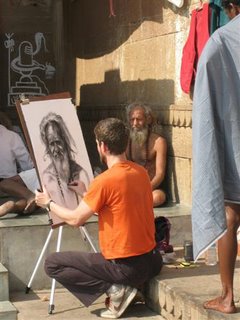Poo pooja at Varanasi


Don't get me wrong - I grew up on a farm where "portable cowpats" made excellent frisbees but even for me the excremental environment is an issue (sic)! Poo from many species abounds, on the streets, in the alleys, in the corners, under your feet, on the walls (drying in palm-printed dung cakes for smoky fuel later) and in the water, where bacteria of faecal origin are at over 3000 times the limit deemed safe (in the West) for bathing. But bathing people are, and doing pooja (prayer ceremony, that is) - and in their thousands every day - as they have done for millenia at this focal pilgrimage centre for Hindus. They come from all over India, from all classes, cultural persuasions and styles, from the dread-locked sadhu to the city poseur in designer gear and attitude, all to immerse themselves in Ganga Mata, the mother river of north India. Lurking round the edges are the spiritual hitchhikers and ethnic voyeurs of the backpacker trail as well as some who shun the bargain basement and so are probably less well prepared for all this. We visitors from cultural outer space seem somehow to have a niche, a role even, and are almost totally tolerated, even those who push forward intrusively, camera in hand, to the heart of the bathing activity.
All the filth and stench perhaps contribute to the spirituality of the place: the material world is so unsatisfactory that the path of the spirit seems more appealing. The shift of focus from the physical to the metaphysical is almost explicitly prompted. But of course it's not intentional, nor am I suggesting that by neglecting our sewers we in the richer cleaner world might be persuaded to turn our minds to higher things!
It's a world of the elements, particularly of water and fire, the river and the pyres - but also of air, full of smoke and incense, and earth, represented by the matter underfoot.
It's at the burning ghats that even the tourists behave themselves, at a distance, cameras sheathed, as bodies are throughly dunked in the sacred river before being set on woodpiles of selected timber drawn from immense stacks further up the bank. Fire meets water and then, fire over, ashes are swept into the water to be carried blessedly away. For some, myself included, a little of this easily suffices - not that death or cremation repels but that it's hardly a spectator sport and being downwind is not to be recommended.
I shan't try fully to describe Varanasi but it is clear that it fascinates, despite much of the above. The vision and the ambience of adherents of an age-old religion reliving time-worn traditions with intent and conviction, immune to distractions of intruders, must impress most who visit and who then find themselves reluct to tear themselves away. For Hindus it's a place to die and be cremated: for foreign visitors it's a place to wonder.

0 Comments:
Post a Comment
<< Home